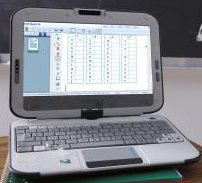Dell convertible has unusual hinge design
Sep 15, 2010 — by LinuxDevices Staff — from the LinuxDevices Archive — 10 viewsDell will release a convertible mobile device later this year that can be either used as a tablet PC, or reconfigured into a netbook-style machine complete with a keyboard. The Inspiron Duo was shown off during an Intel Developer Forum (IDF) keynote yesterday by Dell executive David Zavelson.
The Inspiron Duo was one of many devices — such as netbooks, tablets, handhelds and embedded offerings — powered by Intel's Atom chip, a major focus of the IDF event. It's said the device will be powered by a dual-core Atom chip, and will include a touch interface developed by Dell that will offer one-touch access to applications and content.
Zavelson showed the device running a movie and video game in its tablet mode. When asked by Doug Davis, general manager of Intel's Embedded and Communications Group, whether it could be used in a work environment, Zavelson quickly reconfigured it via a swiveling screen to show the keyboard. He then sent an e-mail from the device.

Dell's Inspiron Duo has an unusual hinge design
(Click to enlarge)
Unlike existing convertible tablets, where screens are rotated using a central hinge at the bottom, the Inspiron Duo's display pivots around two hinges at the sides of its bezel, as pictured above. Few other details about the device were revealed, but Zavelson did say it would be out later this year.
The demonstration was part of a presentation by Intel's Davis showing the growing reach of the Atom platform, which was released two years ago initially for the netbook space. Since that time, Davis said, Intel has been pushing the platform in other directions, including embedded devices, consumer electronics and mobile phones.
During a question-and-answer session following the keynote, Davis admitted that currently Atom is primarily a netbook chip, noting that Intel has sold more than 70 million chips for netbooks. However, he said, momentum is building in the company's efforts to expand the platform's reach.
"We're on our way," he said.
New offerings in the Atom portfolio reflect that effort. As we reported yesterday, Intel has unveiled the Atom E6xx, designed for embedded applications such as automobile "infotainment" systems, smart grid devices and IP media phones.
Davis also showed off the Atom CE4200 processor, another SoC designed to facilitate the integration of the Internet and television. The 45-nanometer CE4200 chip offers three-dimensional graphics support, H.264 high-definition encoding capabilities, and smart power management features that automatically turn off parts of the chip when they're not in use.
In addition, Davis talked briefly about another new Atom processor, "Stellarton", a configurable chip that combines the Atom E600 with an Altera FPGA (field-programmable gate array). Stellarton will be available in the first half of 2011.
Intel also gave the first demonstration of its upcoming "Oak Trail" on a traditional-looking tablet and a smaller handheld gaming device running Windows 7. Both will be available next year, Davis said.
Korean OEM Ocosmos will release a five-inch gaming tablet in February 2011 that will be powered by an Oak Trail chip and will run Windows 7, Intel officials said. (Images depicting the device may be found on the Engadget website, here.)

Intel's N450-based Classmate
Finally, Intel used the event to hype a refresh of another Atom-powered device, its Classmate portable computer for kids. The device was upgraded in March to include a 1.66GHz Atom N450 processor, an available 1366 x 768 pixel screen, a six-cell battery, plus a water-resistant keyboard and touchpad, among other features.
As promoted this week, the Classmate does not appear to have received any further technical changes. However, Intel touted the device's antimicrobial coating, which "helps create a healthier and cleaner classroom."
Jeffrey Burt is a writer for our sister site eWEEK.com.
This article was originally published on LinuxDevices.com and has been donated to the open source community by QuinStreet Inc. Please visit LinuxToday.com for up-to-date news and articles about Linux and open source.